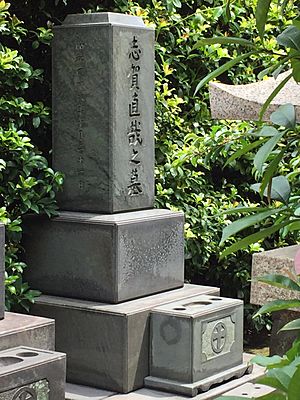Naoya Shiga facts for kids
Quick facts for kids
Naoya Shiga
|
|
|---|---|
 |
|
| Native name |
志賀直哉
|
| Born | February 20, 1883 Ishinomaki-chō, Oshika-gun, Miyagi Prefecture, Empire of Japan |
| Died | October 21, 1971 (aged 88) Kantō Central Public Hospital, Kamiyoga, Setagaya-ku, Tokyo, Japan |
| Resting place | Aoyama Cemetery, Tokyo, Japan |
| Occupation | Writer |
| Language | Japanese |
| Genre | I-novel |
| Literary movement | Modernism |
Naoya Shiga (志賀直哉, Shiga Naoya, February 20, 1883 – October 21, 1971) was an important Japanese writer. He was active during the Taishō and Shōwa periods in Japan. His writing style was clear and direct. Many of his stories were based on his own life experiences.
Contents
Early Life and Family
Shiga was born in Ishinomaki, Miyagi Prefecture. His father was a banker, and his family came from a noble samurai background. In 1885, his family moved to Tokyo. Shiga was then raised by his grandparents.
When he was twelve, his mother passed away. This sad event made him think a lot about life and death. It stayed with him until he was in his early thirties. He also had a difficult relationship with his father. They sometimes disagreed, especially about social issues. For example, his father didn't want him to join protests related to a copper mine incident. This was partly because their family had invested in the mine.
Shiga loved nature, which inspired his imagination. He enjoyed reading books by Thomas Carlyle and Ralph Waldo Emerson. He also liked Lafcadio Hearn's stories about supernatural things. At 18, Shiga became a Christian for a while. He found it challenging to follow his new faith.
He finished elementary school in 1906. Then he started studying English literature at Tokyo Imperial University. However, he left after two years without finishing his degree. Later, he wanted to marry a housemaid, but his father did not approve. The marriage did not happen.
Starting a Literary Career
In 1910, Shiga helped start a magazine called Shirakaba ("White Birch"). This was the main publication of the Shirakaba-ha ("White Birch Society"). Other writers he befriended, like Saneatsu Mushanokōji and Takeo Arishima, also helped.
The Shirakaba-ha group had new ideas. They didn't agree with older ways of thinking like Confucianism or Naturalism. Instead, they believed in individualism (being yourself), idealism (believing in good things), and humanitarianism (caring for others). The Russian writer Leo Tolstoy was a big role model for them. Shiga's story As Far as Abashiri was in the first issue of the magazine.
In the next few years, Shiga wrote many short stories. Some of these include The Razor (1910), Han's Crime (1913), and Seibei and his Gourds (1913).
The I-Novel Style
In 1912, Shiga published Ōtsu Junkichi. This was his first story that he got paid for. It was an autobiographical story about his family conflicts. In this story, Shiga used a new way of writing. He told the story from his own point of view, like a diary. This style is a key part of the I-novel genre, which many of Shiga's works are known for. While writing Ōtsu Junkichi, Shiga read an English translation of The Crime of Sylvestre Bonnard by Anatole France. He said this book greatly influenced his own writing.
In 1914, Shiga married Sada Kadenokōji. She was a widow with a young daughter. This marriage caused a complete break with his father. However, in 1917, he made up with his father. He wrote about this in his novella Reconciliation (1917).
He then wrote more short stories. His most famous work is A Dark Night's Passing (1921–1937). This was his only full-length novel. It was published in parts in a magazine called Kaizō. The main character, Kensaku, is a young writer who faces challenges. Many people think Kensaku is based on Shiga himself.
Influence on Other Writers
Shiga's writing had a big impact on many writers who came after him. Some of these include Kazu Ozaki, Kiku Amino, and Motojirō Kajii. Famous writers like Ryūnosuke Akutagawa and Sei Itō praised his work. However, others like Dazai Osamu and Mitsuo Nakamura were critical of it.
Jun'ichirō Tanizaki admired Shiga's clear and practical writing style. He noted that Shiga removed any words that were not absolutely needed.
Later Life and Legacy
Shiga wrote very few new works in his later years. Some of these included short stories like A Gray Moon (1946) and Yamabato (1951). He also wrote essays, such as Kokuko mondai (1946). In this essay, he suggested making French the national language of Japan.
He was the first president of the Japan PEN Club after World War II, from 1947 to 1948. In 1949, he received the Order of Culture, a high honor in Japan.
Naoya Shiga passed away from pneumonia on October 21, 1971. He was at the Kantō Central Public Hospital in Setagaya, Tokyo. His grave is at Aoyama Cemetery in Tokyo. His house in Nara, where he lived from 1929 to 1938, is now a museum. Visitors can learn about his life and work there.
Selected Works
- 1910: As Far as Abashiri (Abashiri made)
- 1910: The Razor (Kamisori)
- 1911: Nigotta atama
- 1912: Ōtsu Junkichi
- 1913: Han's Crime (Han no hanzai)
- 1913: Seibei and his Gourds (Seibei to hyotan)
- 1917: At Kinosaki (Kinosaki ni te)
- 1917: The Case of Sasaki (Sasaki no baai)
- 1917: Reconciliation (Wakai)
- 1917: Kōjinbutsu no fūfu
- 1920: The Shopboy's God (Kozō no kamisama)
- 1920: Manazuru
- 1920: Bonfire (Takibi)
- 1921–1937: A Dark Night's Passing (An'ya koro)
- 1926: A Memory of Yamashina (Yamashina no kioku)
- 1926: Infatuation (Chijo)
- 1927: Kuniko
- 1946: A Gray Moon (Haiiro no tsuki)
See also
 In Spanish: Naoya Shiga para niños
In Spanish: Naoya Shiga para niños


